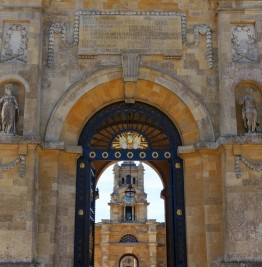Blenheim Palace: the English answer to Versailles?
(vero;2022-July-16)
You can also check our photo gallery dedicated to Blenheim Palace.
Vero had been wanting to see Blenheim Palace for a long time but the entry price being quite hefty (35£ in 2023 for the palace, park and gardens) we had always postponed the outing until we became member of English Heritage: this gave us a 30% discount so we decided it was about time to visit and Vero's 59th seemed the perfect occasion. The normal palace entry fee gives access to the palace State Rooms on the ground floor only. The Spencer-Churchill family still occupy the upstairs rooms which can be visited in small groups of ten for an extra 5£ when they are not around. There is also a "Downstairs Tour" costing another 5£ which provides visitors with a glimpse into the lives of palace staff over the centuries. We booked neither of them. Be aware that your entry ticket gives you access to the palace for one year, so if you feel like returning, make sure to keep your e-ticket as a proof or to play it safe, you can also go to the visitor booth on the day of your first visit and ask them for a paper card.
But first a bit of background:
- 1704: the War of the Spanish Succession is raging. On one side: Louis XIV's France and the Bavarian Electorate, on the other side: the Grand Alliance gathering England, the United Provinces, Portugal and the Holy Roman Empire.
- 13 August 1704: the Battle of Blenheim (named after the village of Blindheim in Bavaria where it took place). On that day Louis XIV's army was defeated by the army of the Grand Alliance led by a certain John Churchill 1st Duke of Marlborough.
- As a result of his resounding victory John Churchill became a national hero and to thank him on behalf of the grateful nation Queen Anne of England granted him a huge estate taken from the Crown at Woodstock near Oxford as well as a substantial amount of money to build a palace worthy of his exploits. This palace, begun in 1705 but plagued by financial troubles only really completed in 1733, became known as Blenheim Palace. It is the only non-royal residence allowed to be called a palace.
- We are now counting the 12th Duke and the succession seems ensured since the birth of the future 13th Duke in 1992. Click here for a timeline showing all Dukes of Marlborough.
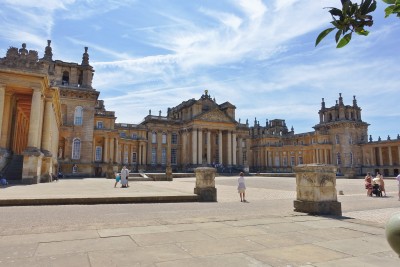 From an architectural point of view we found Blenheim a bit of a monstrosity: baroque style, disproportionate dimensions, it is a sight to behold (which is the desired effect of course). As soon as we arrived we thought of Versailles (which we think more elegant and flamboyant): the monumental entrance portico, the large courtyard, the building itself. As in Versailles there were many tourists (we were there on a Saturday) but given the price of admission many visitors stick to the gardens (20.50£ in 2022) so the visit of the interior was not crowded at all and quite pleasant compared to what we had experienced in Versailles.
From an architectural point of view we found Blenheim a bit of a monstrosity: baroque style, disproportionate dimensions, it is a sight to behold (which is the desired effect of course). As soon as we arrived we thought of Versailles (which we think more elegant and flamboyant): the monumental entrance portico, the large courtyard, the building itself. As in Versailles there were many tourists (we were there on a Saturday) but given the price of admission many visitors stick to the gardens (20.50£ in 2022) so the visit of the interior was not crowded at all and quite pleasant compared to what we had experienced in Versailles.
The palace as it stands today has not changed since it was built so it is John Churchill's creation that we saw (and of his architect John Vanbrugh) and if you ask us we suspect him to have had a serious personality problem with Louis XIV his sworn enemy: a case of "mine is bigger than yours" (excuse the triviality).
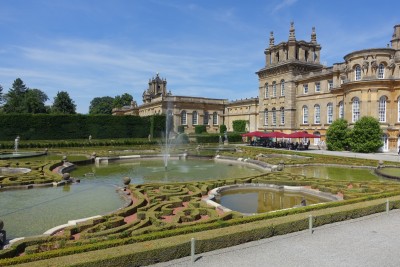 As for the gardens they have evolved over the generations but bear the mark of Capability Brown who remodelled them in 1764 in the English landscape garden style: a large artificial lake, a long perspective to the column of victory erected in the times of the 1st Duke and a huge park.
As for the gardens they have evolved over the generations but bear the mark of Capability Brown who remodelled them in 1764 in the English landscape garden style: a large artificial lake, a long perspective to the column of victory erected in the times of the 1st Duke and a huge park.
The palace is in fact a hymn to the glory of the man John Churchill was, to his greatness, his war record and his reputation and to the image he wanted to leave to posterity. Modesty was not his thing. Busts of Roman emperors, Alexander the Great, martial and virile symbols are displayed throughout the palace not to mention ten truly splendid tapestries recounting the famous battle of Blenheim and other campaigns led by the 1st Duke. What was most surprising was to find oneself suddenly (and often) in front of busts and portraits of… Louis XIV of all people! An interesting example of love-hate: in one of the rooms a panel pointed to some chairs covered with a red fabric on which was printed the face of the Sun King. This meant that when sitting on them people had their behind on the face of you know who!
The interior arrangement of the rooms has of course been added to and modified by the various generations and alongside the original objects (among others the splendid tapestries and some pieces of furniture made by André Charles Boulle the famous French cabinetmaker of Louis XIV) there are numerous portraits of the various dukes, their families and other nobles of the time. Objects collected over the years such as precious vases, silverware, porcelain and furniture are on display in all the rooms. We particularly liked the many clocks: there is at least one in each room and some of them are magnificent. Time was of the essence and the Dukes of Marlborough made sure that the whole household was in sync: no excuse for being late especially not for the servants! At the end of the tour the visitor enters an impressive 55m long gallery serving as a library with walls full of books (more than 10,000 volumes we've been told): on one end stands a statue of Queen Anne facing a monumental pipe organ at the other end.
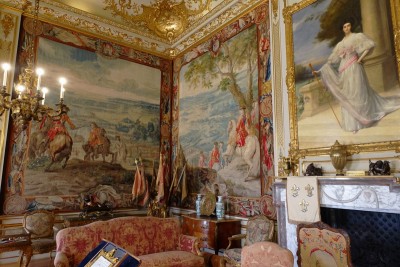 Maintaining such a house obviously costs a fortune and so it came that at the end of the 19th century the 9th Duke found himself in a dire financial position: so in 1895 he wed the wealthy American railroad heiress Consuelo Vanderbilt with the sole aim of using her fortune to put the palace back on its feet. It was a loveless and tragic marriage for Consuelo who did not want it but was pushed into it by her mother who dreamed of a title of nobility for the family. The Duke is said to have told Consuelo before the wedding that he was only marrying her to save Blenheim which of course is not the best start for a marriage.
Maintaining such a house obviously costs a fortune and so it came that at the end of the 19th century the 9th Duke found himself in a dire financial position: so in 1895 he wed the wealthy American railroad heiress Consuelo Vanderbilt with the sole aim of using her fortune to put the palace back on its feet. It was a loveless and tragic marriage for Consuelo who did not want it but was pushed into it by her mother who dreamed of a title of nobility for the family. The Duke is said to have told Consuelo before the wedding that he was only marrying her to save Blenheim which of course is not the best start for a marriage.
A guide told us a small anecdote which made us smile and illustrates the state of their union: in the dining room there is a huge piece of silverware representing the 1st Duke on horseback: Consuelo made it a point of honour to have this monstrosity enthroned in the middle of the table so that, she said, she didn't have to bear the sight of her husband during the meal. What an atmosphere! They separated in 1906 and divorced in 1921.
In the palace is also the room where Winston Churchill was born: he was not a Duke of Marlborough himself and so did not live in the palace as such but his paternal grandfather was the 7th Duke and his mother happened to be at Blenheim when she went into labour. Churchill was often at Blenheim visiting his cousins and spent many happy times there. It was in Blenheim that he proposed to his future wife Clementine and he is buried in the small village of Bladon just outside the Palace Park.
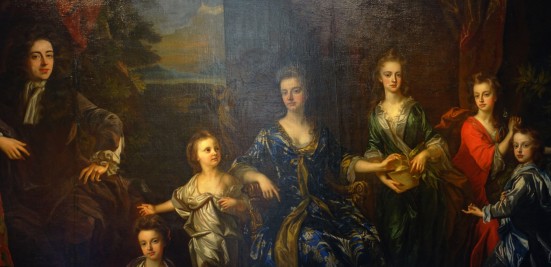 A small piece of trivia to finish: the 1st Duke John Churchill died without a male heir. To safeguard the title an Act of Parliament passed the title to Henrietta his eldest daughter (a rare occurrence) who thus became 2nd Duchess of Marlborough. Unfortunately Henrietta's son died in infancy and she herself died without a male heir. The title should then have passed to Anne the second daughter of the 1st Duke but unfortunately she was already dead: so it was Anne's son Charles who inherited the title and became 3rd Duke of Marlborough. But Anne had married a certain Charles Spencer which meant that the 3rd Duke of Marlborough was no longer called Churchill but Spencer after his father's name which was less glorious. Therefore from the 5th Duke onwards the dynasty decided to complete the Spencer surname with the addition of Churchill to mark the lineage… Thus the Dukes of Marlborough have since borne the surname Spencer-Churchill. Why this information? Well… just to point out that Lady Diana Spencer the future Princess of Wales was a distant descendant of the Dukes of Marlborough. Click here for a family tree of the Spencer-Churchill family.
A small piece of trivia to finish: the 1st Duke John Churchill died without a male heir. To safeguard the title an Act of Parliament passed the title to Henrietta his eldest daughter (a rare occurrence) who thus became 2nd Duchess of Marlborough. Unfortunately Henrietta's son died in infancy and she herself died without a male heir. The title should then have passed to Anne the second daughter of the 1st Duke but unfortunately she was already dead: so it was Anne's son Charles who inherited the title and became 3rd Duke of Marlborough. But Anne had married a certain Charles Spencer which meant that the 3rd Duke of Marlborough was no longer called Churchill but Spencer after his father's name which was less glorious. Therefore from the 5th Duke onwards the dynasty decided to complete the Spencer surname with the addition of Churchill to mark the lineage… Thus the Dukes of Marlborough have since borne the surname Spencer-Churchill. Why this information? Well… just to point out that Lady Diana Spencer the future Princess of Wales was a distant descendant of the Dukes of Marlborough. Click here for a family tree of the Spencer-Churchill family.
There is plenty to see in Blenheim Palace and its huge grounds and the good thing about the entry ticket is that it is valid for one year which means we will certainly return. And we did!
Don't forget to check our photo gallery of Blenheim Palace.
Want to read more? Go back to Wellington and Apsley House or go on to Petworth House: grand palatial house turned museum or go up to Blog
$ updated from: Blog.htxt Mon 28 Apr 2025 14:55:35 trvl2 — Copyright © 2025 Vero and Thomas Lauer unless otherwise stated | All rights reserved $




